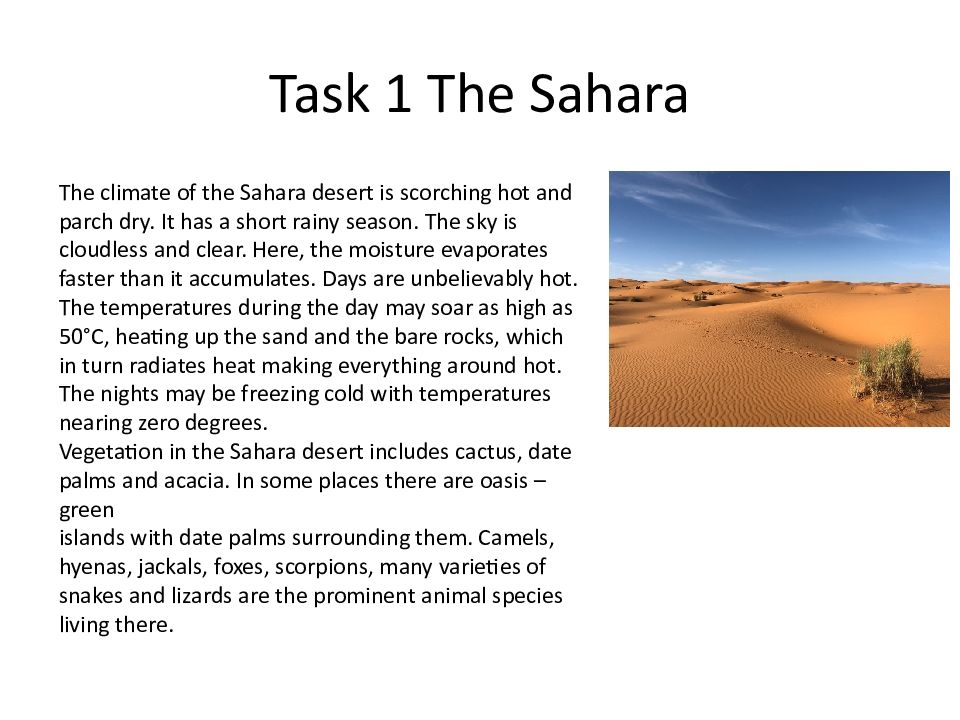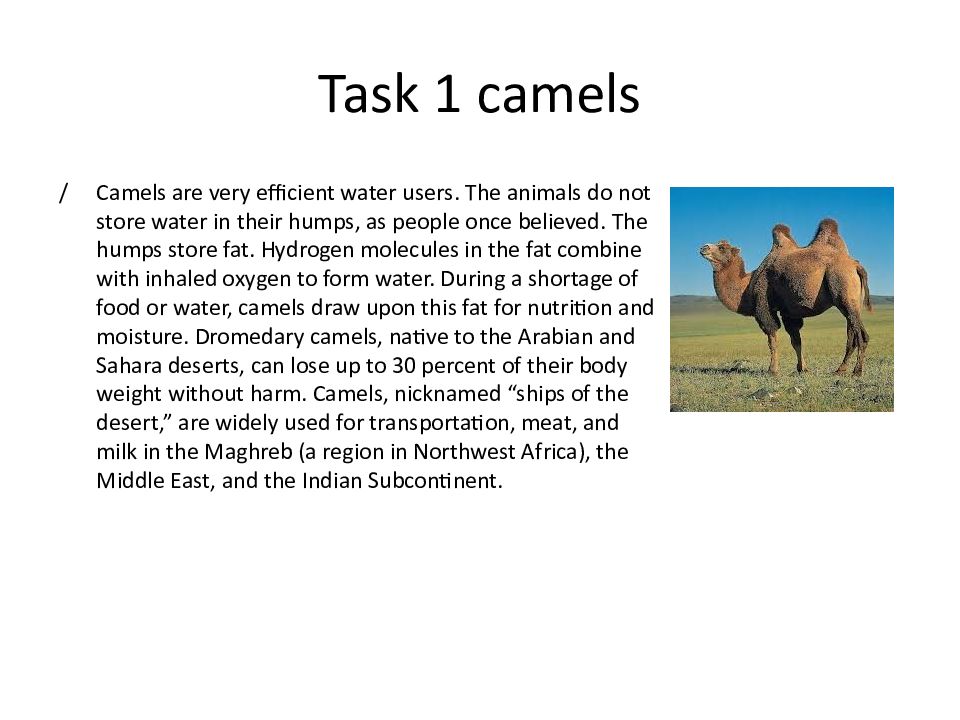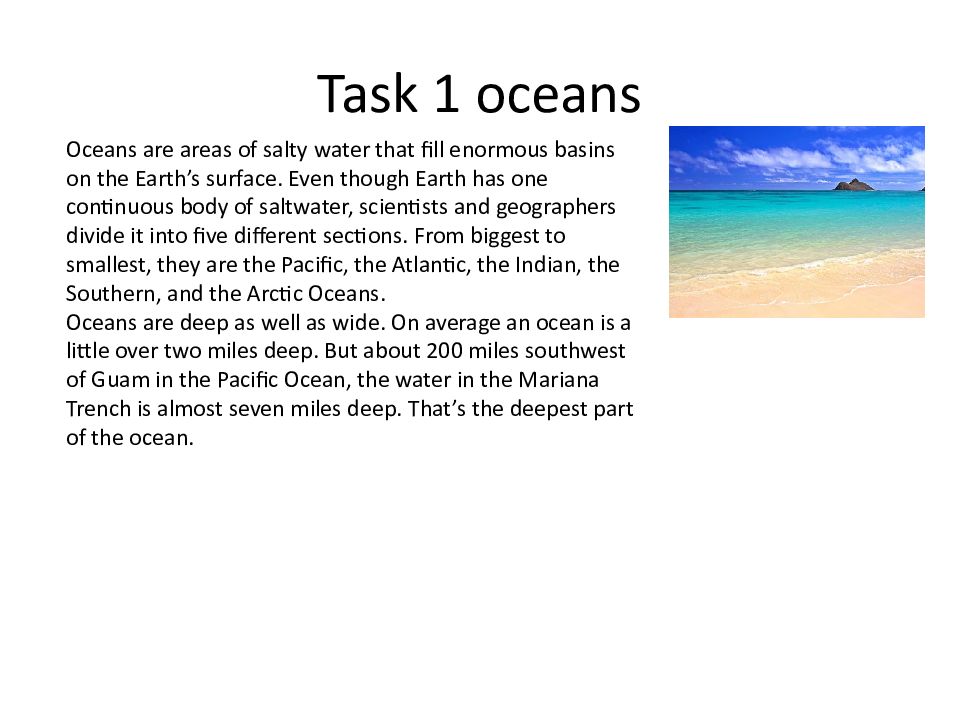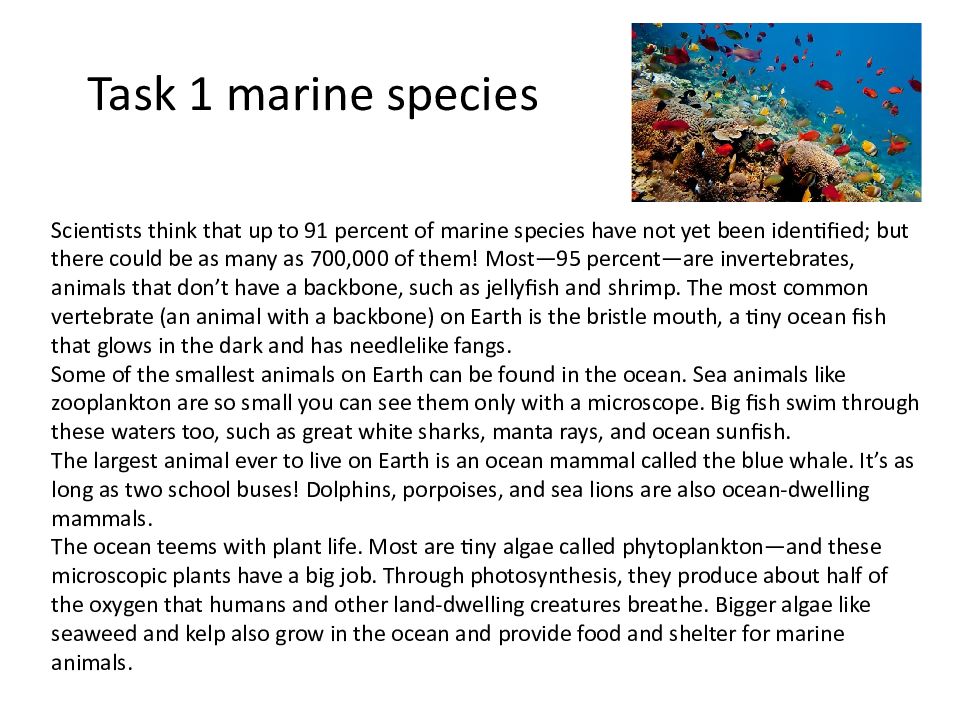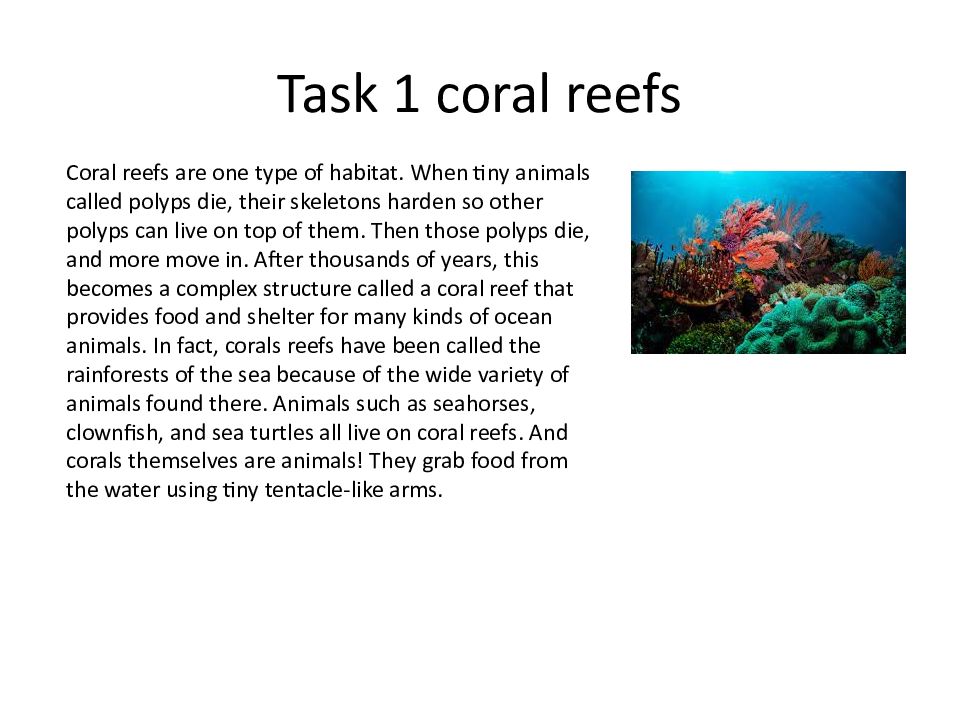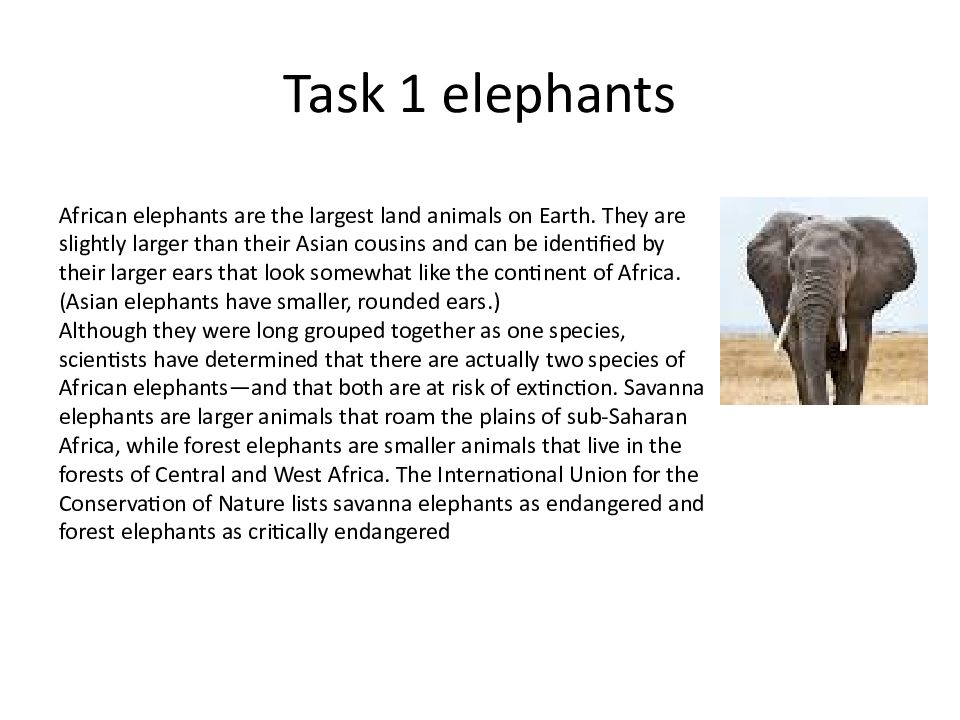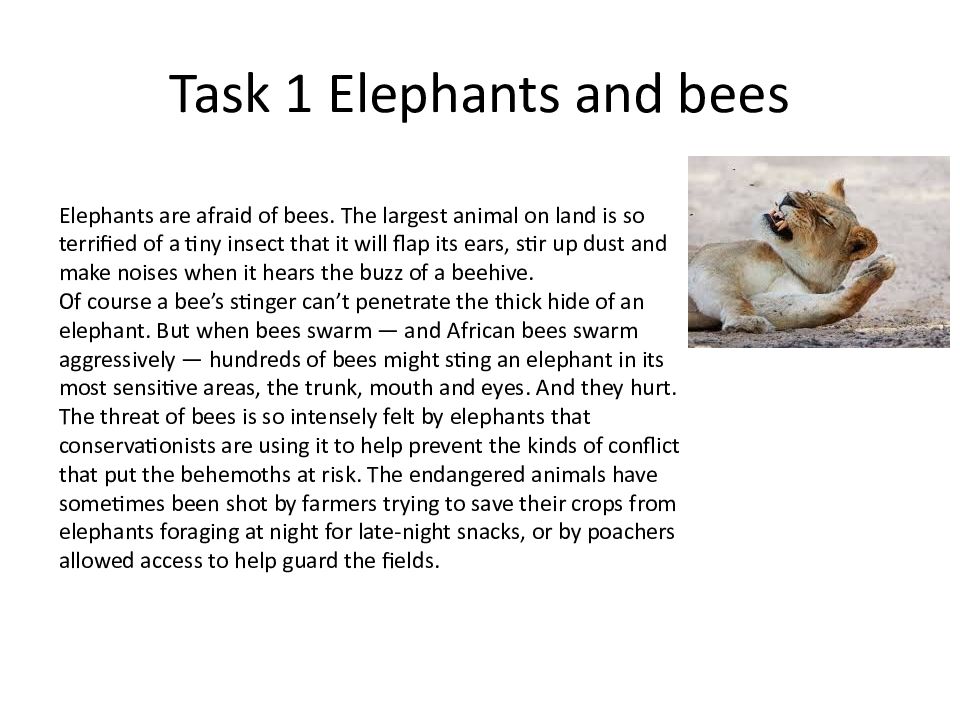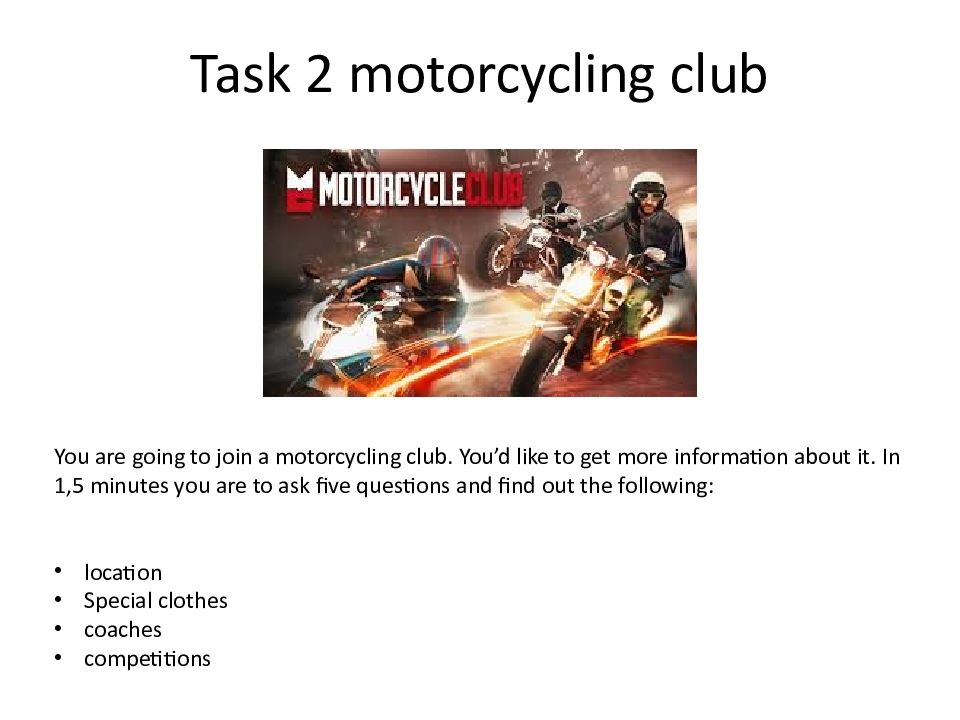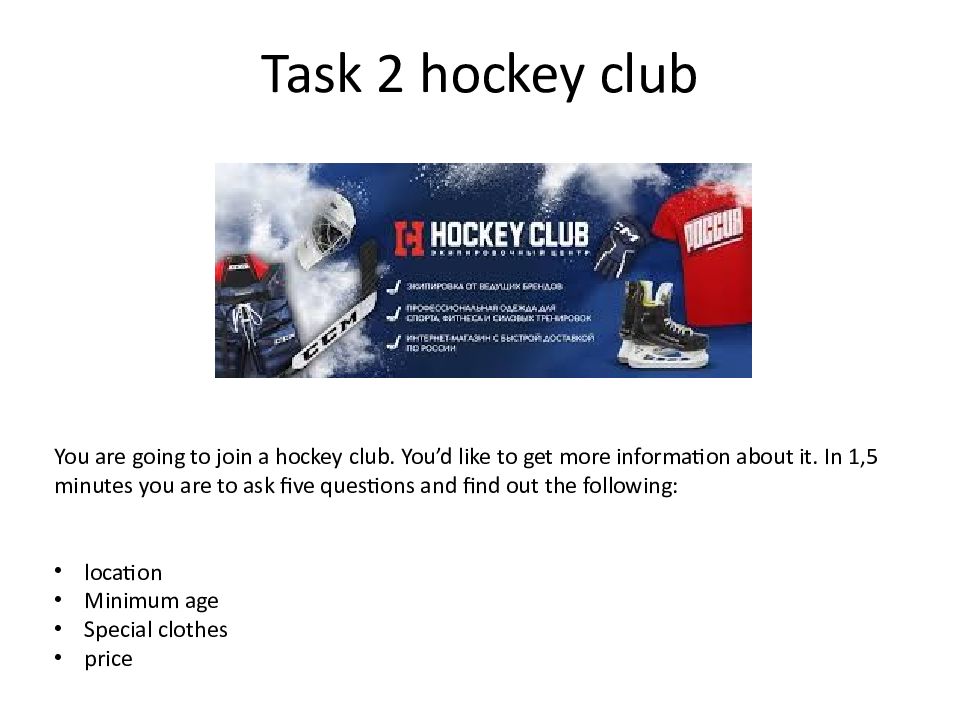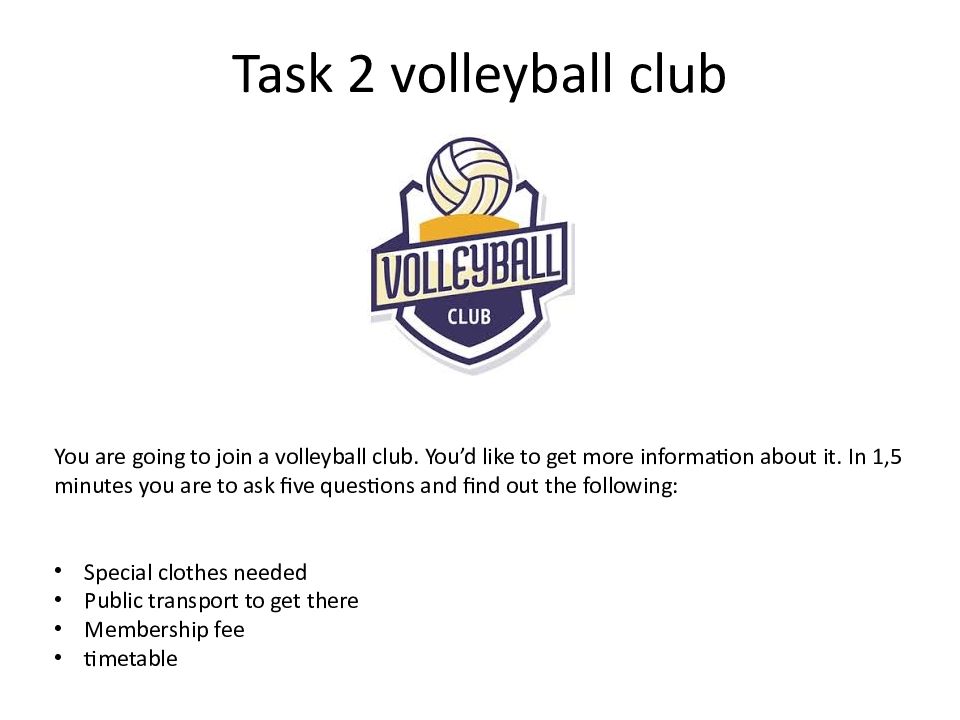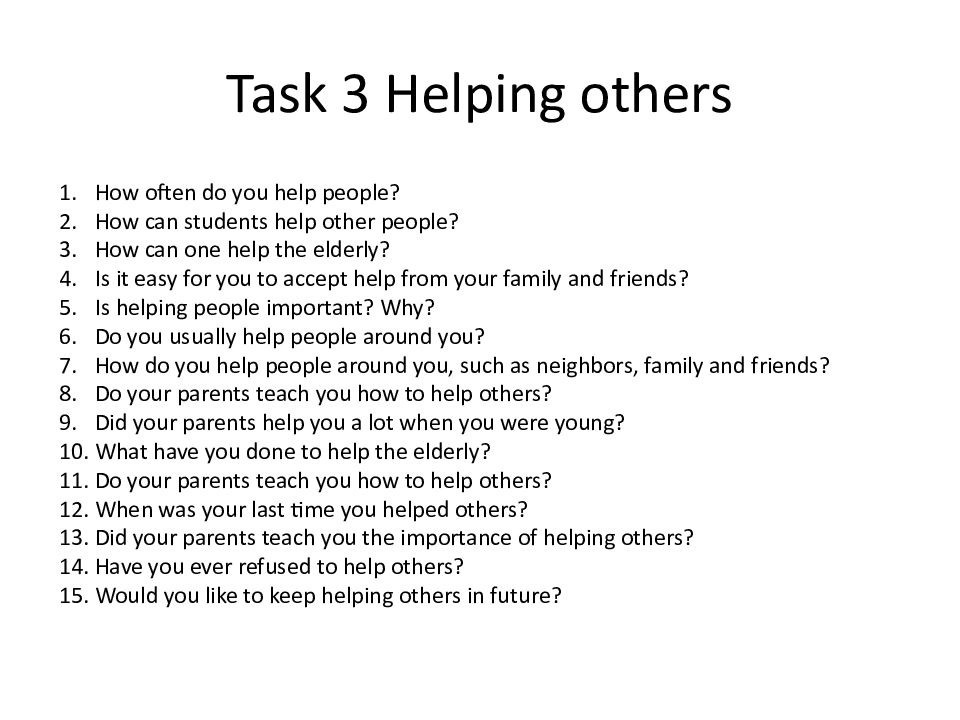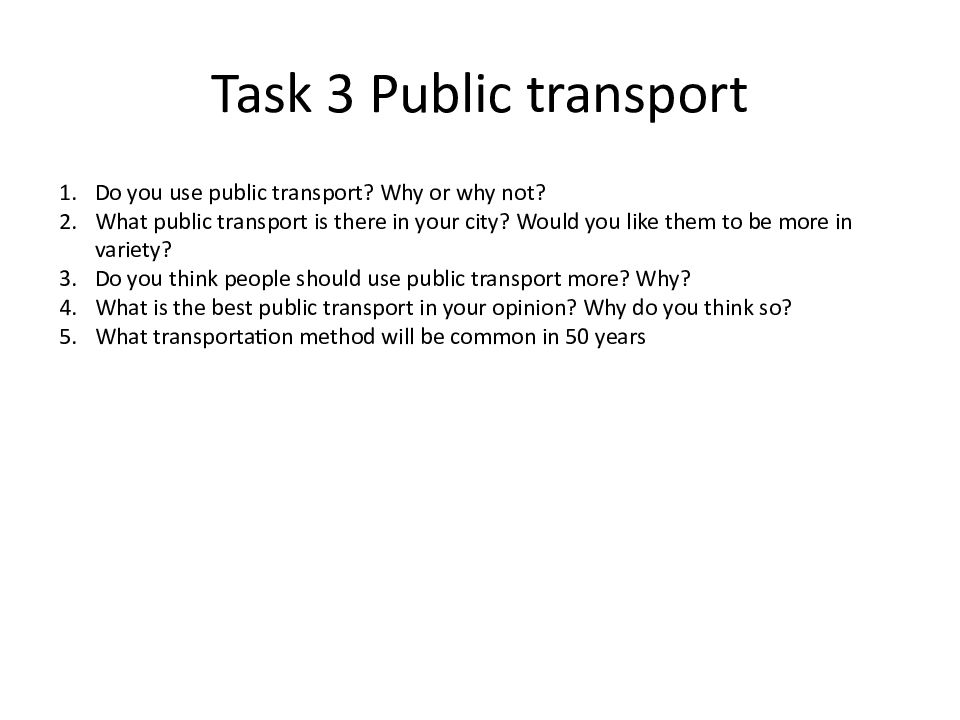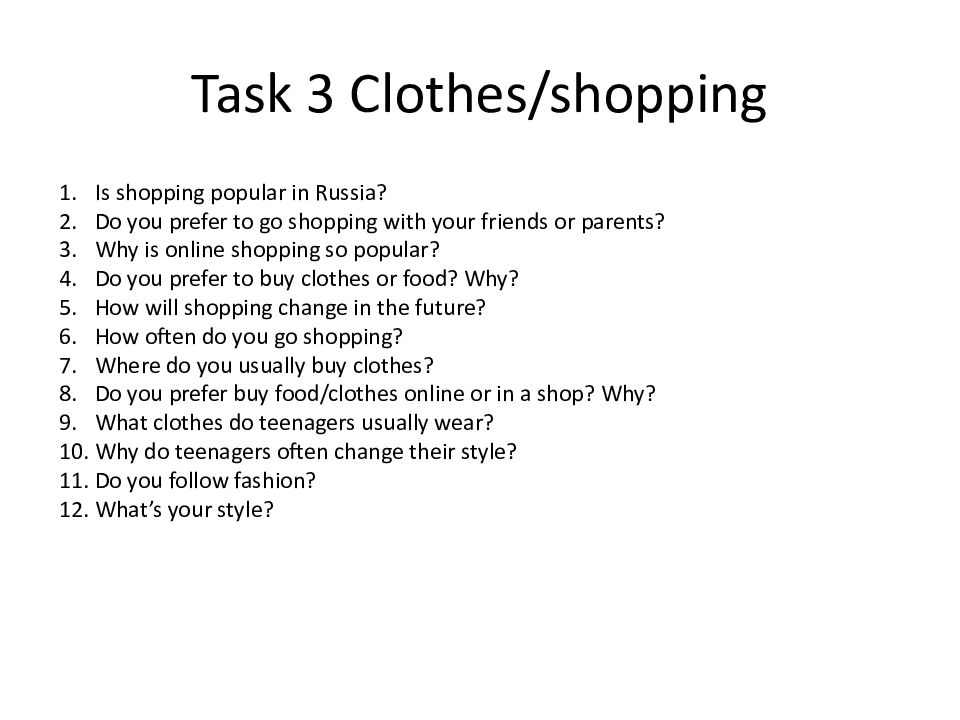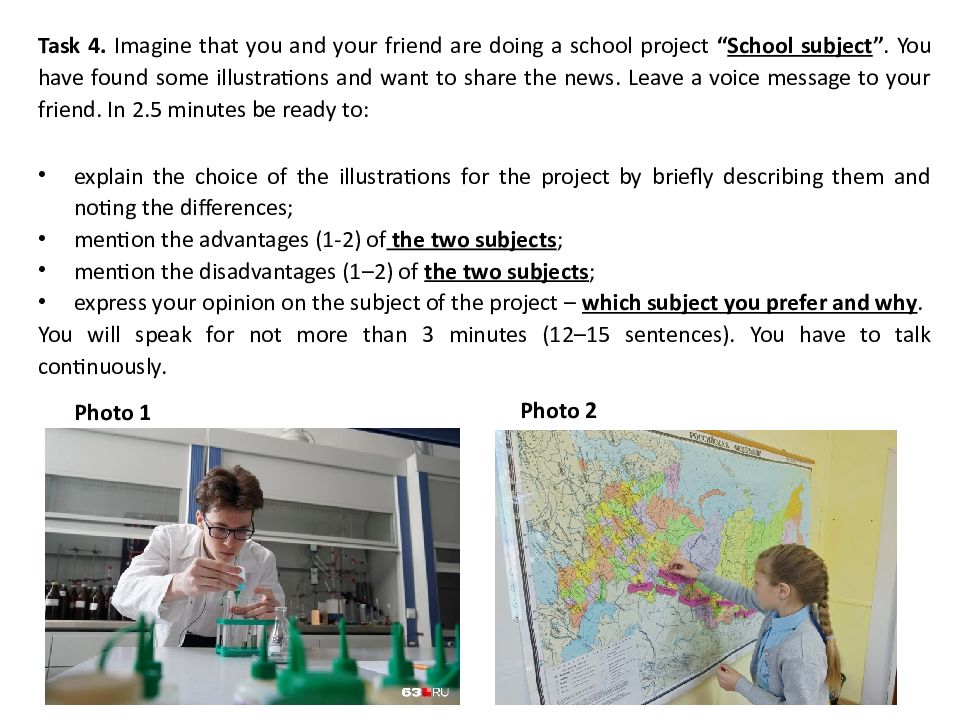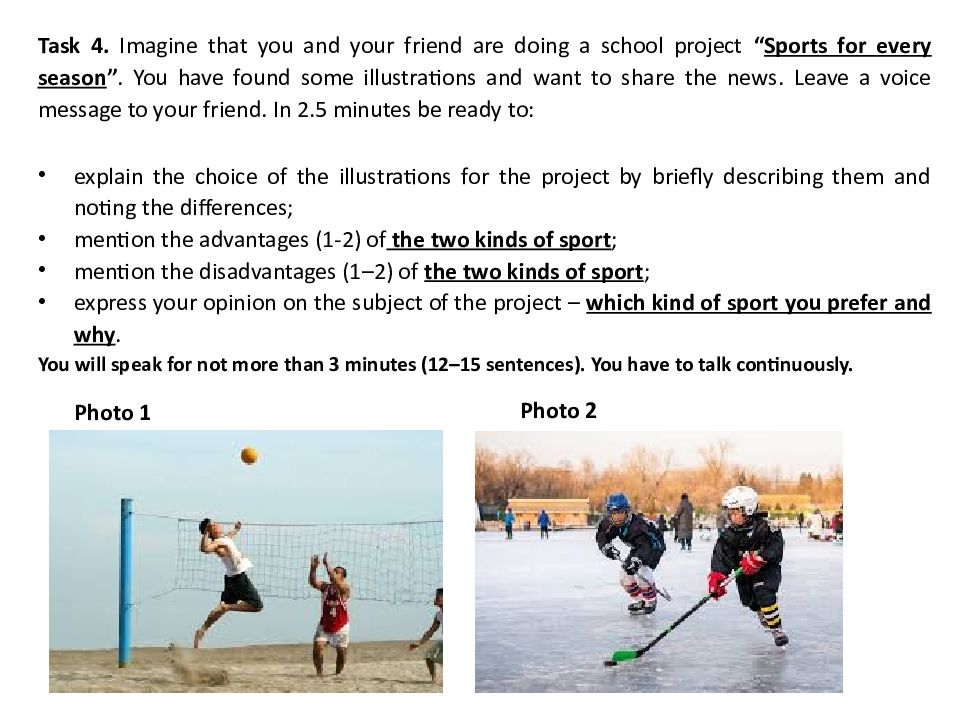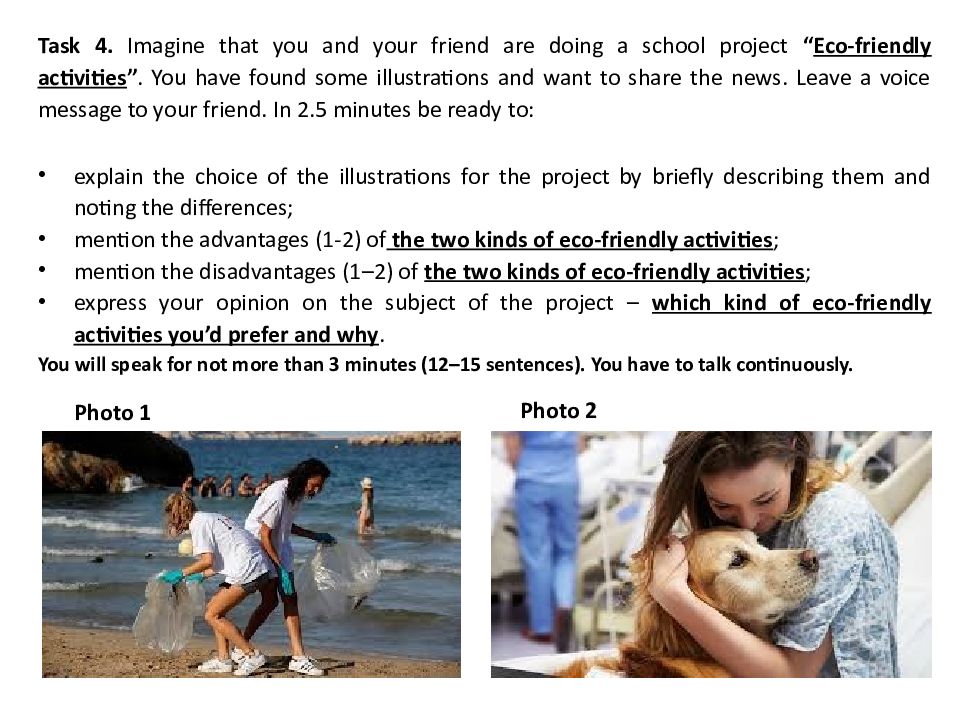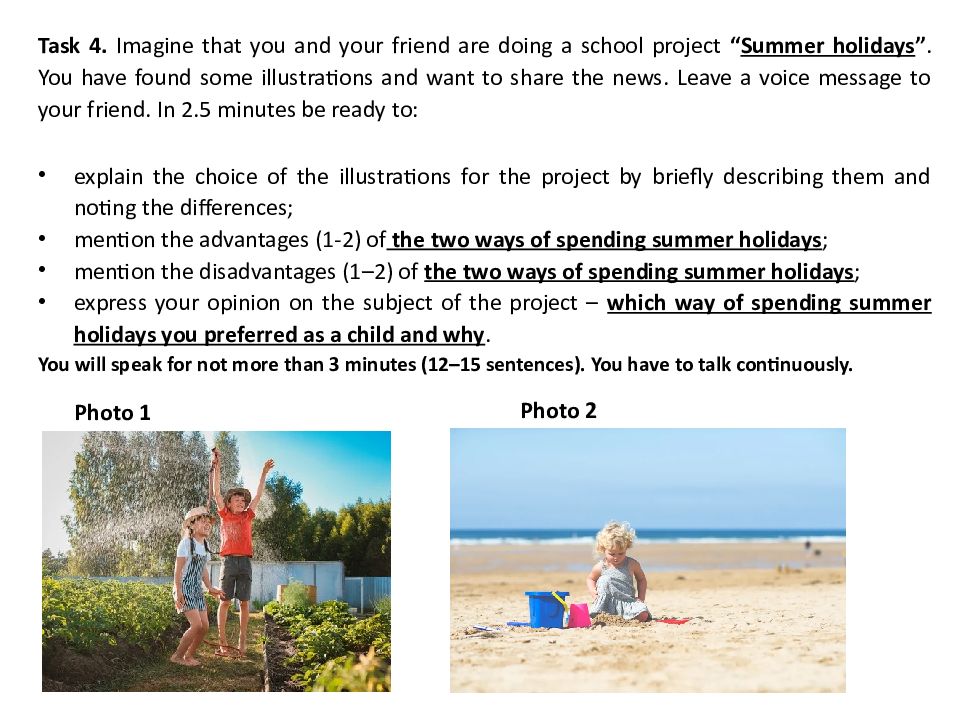Слайд 2: Task 1 The Sahara
The climate of the Sahara desert is scorching hot and parch dry. It has a short rainy season. The sky is cloudless and clear. Here, the moisture evaporates faster than it accumulates. Days are unbelievably hot. The temperatures during the day may soar as high as 50°C, heating up the sand and the bare rocks, which in turn radiates heat making everything around hot. The nights may be freezing cold with temperatures nearing zero degrees. Vegetation in the Sahara desert includes cactus, date palms and acacia. In some places there are oasis – green islands with date palms surrounding them. Camels, hyenas, jackals, foxes, scorpions, many varieties of snakes and lizards are the prominent animal species living there.
Слайд 3: Task 1 camels
/ Camels are very efficient water users. The animals do not store water in their humps, as people once believed. The humps store fat. Hydrogen molecules in the fat combine with inhaled oxygen to form water. During a shortage of food or water, camels draw upon this fat for nutrition and moisture. Dromedary camels, native to the Arabian and Sahara deserts, can lose up to 30 percent of their body weight without harm. Camels, nicknamed “ships of the desert,” are widely used for transportation, meat, and milk in the Maghreb (a region in Northwest Africa), the Middle East, and the Indian Subcontinent.
Слайд 4: Task 1 oceans
Oceans are areas of salty water that fill enormous basins on the Earth’s surface. Even though Earth has one continuous body of saltwater, scientists and geographers divide it into five different sections. From biggest to smallest, they are the Pacific, the Atlantic, the Indian, the Southern, and the Arctic Oceans. Oceans are deep as well as wide. On average an ocean is a little over two miles deep. But about 200 miles southwest of Guam in the Pacific Ocean, the water in the Mariana Trench is almost seven miles deep. That’s the deepest part of the ocean.
Слайд 5: Task 1 marine species
Scientists think that up to 91 percent of marine species have not yet been identified; but there could be as many as 700,000 of them! Most—95 percent—are invertebrates, animals that don’t have a backbone, such as jellyfish and shrimp. The most common vertebrate (an animal with a backbone) on Earth is the bristle mouth, a tiny ocean fish that glows in the dark and has needlelike fangs. Some of the smallest animals on Earth can be found in the ocean. Sea animals like zooplankton are so small you can see them only with a microscope. Big fish swim through these waters too, such as great white sharks, manta rays, and ocean sunfish. The largest animal ever to live on Earth is an ocean mammal called the blue whale. It’s as long as two school buses! Dolphins, porpoises, and sea lions are also ocean-dwelling mammals. The ocean teems with plant life. Most are tiny algae called phytoplankton—and these microscopic plants have a big job. Through photosynthesis, they produce about half of the oxygen that humans and other land-dwelling creatures breathe. Bigger algae like seaweed and kelp also grow in the ocean and provide food and shelter for marine animals.
Слайд 6: Task 1 coral reefs
Coral reefs are one type of habitat. When tiny animals called polyps die, their skeletons harden so other polyps can live on top of them. Then those polyps die, and more move in. After thousands of years, this becomes a complex structure called a coral reef that provides food and shelter for many kinds of ocean animals. In fact, corals reefs have been called the rainforests of the sea because of the wide variety of animals found there. Animals such as seahorses, clownfish, and sea turtles all live on coral reefs. And corals themselves are animals! They grab food from the water using tiny tentacle-like arms.
Слайд 7: Task 1 elephants
African elephants are the largest land animals on Earth. They are slightly larger than their Asian cousins and can be identified by their larger ears that look somewhat like the continent of Africa. (Asian elephants have smaller, rounded ears.) Although they were long grouped together as one species, scientists have determined that there are actually two species of African elephants—and that both are at risk of extinction. Savanna elephants are larger animals that roam the plains of sub-Saharan Africa, while forest elephants are smaller animals that live in the forests of Central and West Africa. The International Union for the Conservation of Nature lists savanna elephants as endangered and forest elephants as critically endangered
Слайд 8: Task 1 Elephants and bees
Elephants are afraid of bees. The largest animal on land is so terrified of a tiny insect that it will flap its ears, stir up dust and make noises when it hears the buzz of a beehive. Of course a bee’s stinger can’t penetrate the thick hide of an elephant. But when bees swarm — and African bees swarm aggressively — hundreds of bees might sting an elephant in its most sensitive areas, the trunk, mouth and eyes. And they hurt. The threat of bees is so intensely felt by elephants that conservationists are using it to help prevent the kinds of conflict that put the behemoths at risk. The endangered animals have sometimes been shot by farmers trying to save their crops from elephants foraging at night for late-night snacks, or by poachers allowed access to help guard the fields.
Слайд 9: Task 1 weather
Different parts of the world have different climates. Some parts of the world are hot and rainy nearly every day. They have a tropical wet climate. Others are cold and snow-covered most of the year. They have a polar climate. Between the icy poles and the steamy tropics are many other climates that contribute to Earth’s biodiversity and geologic heritage. The range of weather in continental climate regions makes them among the most spectacular sites for weather phenomena. In autumn, for instance, vast forests put on their annual show of brilliant color before shedding their leaves as winter approaches. Thunderstorms and tornadoes, among the most powerful forces in nature, form mostly in continental climates. There are three types of continental climate—warm summer, cool summer, and subarctic. All these climates exist only in the Northern Hemisphere. Usually, continental climates are found in the interior of continents.
Слайд 10
You are going to a take up a part-time job. You’d like to get more information about it. In 1,5 minutes you are to ask five questions and find out the following: Minimum age salary Required numbers of hours per week Variety jobs Task 2 part-time jobs
Слайд 11
You are going to join a motorcycling club. You’d like to get more information about it. In 1,5 minutes you are to ask five questions and find out the following: location Special clothes coaches competitions Task 2 motorcycling club
Слайд 12
You are going to join a hockey club. You’d like to get more information about it. In 1,5 minutes you are to ask five questions and find out the following: location Minimum age Special clothes price Task 2 hockey club
Слайд 13
You are going to join a volleyball club. You’d like to get more information about it. In 1,5 minutes you are to ask five questions and find out the following: Special clothes needed Public transport to get there Membership fee timetable Task 2 volleyball club
Слайд 14: Task 3 Helping others
How often do you help people? How can students help other people? How can one help the elderly? Is it easy for you to accept help from your family and friends? Is helping people important? Why? Do you usually help people around you? How do you help people around you, such as neighbors, family and friends? Do your parents teach you how to help others? Did your parents help you a lot when you were young? What have you done to help the elderly? Do your parents teach you how to help others? When was your last time you helped others? Did your parents teach you the importance of helping others? Have you ever refused to help others? Would you like to keep helping others in future?
Слайд 15: Task 3 Public transport
Do you use public transport? Why or why not? What public transport is there in your city? Would you like them to be more in variety? Do you think people should use public transport more? Why? What is the best public transport in your opinion? Why do you think so? What transportation method will be common in 50 years
Слайд 16: Task 3 Clothes/shopping
Is shopping popular in Russia? Do you prefer to go shopping with your friends or parents? Why is online shopping so popular? Do you prefer to buy clothes or food? Why? How will shopping change in the future? How often do you go shopping? Where do you usually buy clothes? Do you prefer buy food/clothes online or in a shop? Why? What clothes do teenagers usually wear? Why do teenagers often change their style? Do you follow fashion? What’s your style?
Слайд 17
Task 4. Imagine that you and your friend are doing a school project “ School subject ”. You have found some illustrations and want to share the news. Leave a voice message to your friend. In 2.5 minutes be ready to: explain the choice of the illustrations for the project by briefly describing them and noting the differences; mention the advantages (1-2) of the two subjects ; mention the disadvantages (1–2) of the two subjects ; express your opinion on the subject of the project – which subject you prefer and why. You will speak for not more than 3 minutes (12–15 sentences). You have to talk continuously. Photo 1 Photo 2
Слайд 18
Task 4. Imagine that you and your friend are doing a school project “ Sports for every season ”. You have found some illustrations and want to share the news. Leave a voice message to your friend. In 2.5 minutes be ready to: explain the choice of the illustrations for the project by briefly describing them and noting the differences; mention the advantages (1-2) of the two kinds of sport ; mention the disadvantages (1–2) of the two kinds of sport ; express your opinion on the subject of the project – which kind of sport you prefer and why. You will speak for not more than 3 minutes (12–15 sentences). You have to talk continuously. Photo 1 Photo 2
Слайд 19
Task 4. Imagine that you and your friend are doing a school project “ Eco-friendly activities ”. You have found some illustrations and want to share the news. Leave a voice message to your friend. In 2.5 minutes be ready to: explain the choice of the illustrations for the project by briefly describing them and noting the differences; mention the advantages (1-2) of the two kinds of eco-friendly activities ; mention the disadvantages (1–2) of the two kinds of eco-friendly activities ; express your opinion on the subject of the project – which kind of eco-friendly activities you’d prefer and why. You will speak for not more than 3 minutes (12–15 sentences). You have to talk continuously. Photo 1 Photo 2
Последний слайд презентации: EGE 2024 chernovye varianty
Task 4. Imagine that you and your friend are doing a school project “ Summer holidays ”. You have found some illustrations and want to share the news. Leave a voice message to your friend. In 2.5 minutes be ready to: explain the choice of the illustrations for the project by briefly describing them and noting the differences; mention the advantages (1-2) of the two ways of spending summer holidays ; mention the disadvantages (1–2) of the two ways of spending summer holidays ; express your opinion on the subject of the project – which way of spending summer holidays you preferred as a child and why. You will speak for not more than 3 minutes (12–15 sentences). You have to talk continuously. Photo 1 Photo 2

